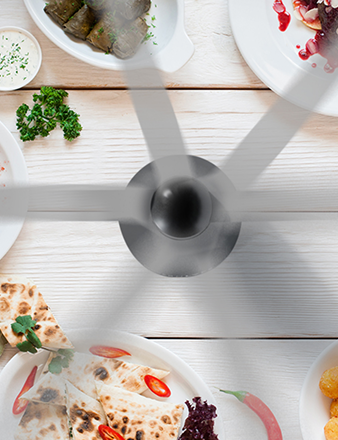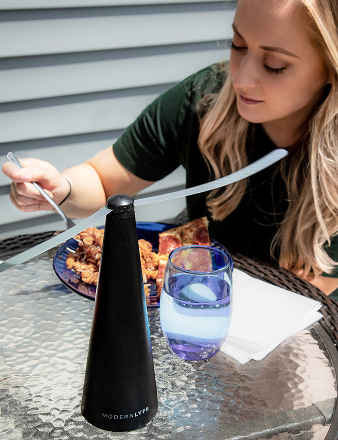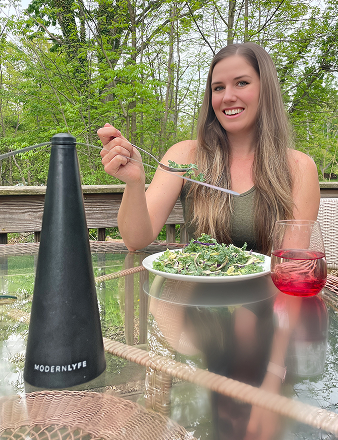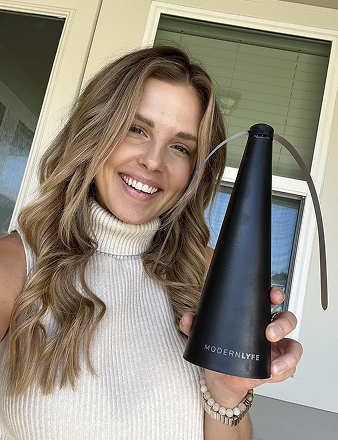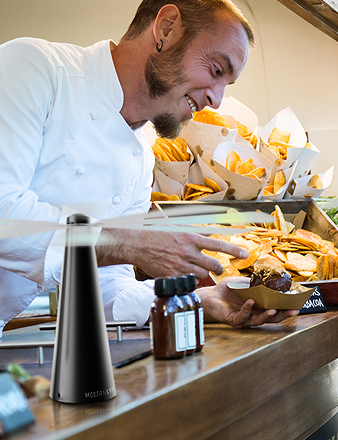Nothing ruins a campsite meal faster than a swarm of flies. It’s not just annoying; it’s a food safety risk that wrecks the outdoor experience you came for.
A fly-free meal isn't a camping fantasy. With a smart strategy, you can make it your reality.
Why Flies Ruin More Than Your Appetite

You know the scene. You’ve just cooked the perfect camp dinner, the sun is setting, and everyone is hungry. Then, the first fly lands on the potato salad. Suddenly, its friends show up, and you’re spending more time swatting than eating.
This isn't just irritating—it's a health hazard. Flies carry bacteria and can contaminate your food in seconds. That relaxing moment turns into a stressful battle, defeating the entire purpose of getting away.
And more people than ever are heading outdoors. The global camping market is on track to hit USD 64.4 billion by 2025, a jump of nearly 7% from the previous year. That means more of us need practical ways to handle common campsite pests.
Bottom line: controlling flies is essential for food safety and your own sanity. It's not about waging war on insects, but about creating a protected zone where you can enjoy your meals in peace.
Fortunately, a few effective tricks can help you reclaim your picnic table. For a broader look, see our guide on how to keep flies away from food outdoors. Here, we’ll focus on one of the best tools for the job: the fly fan.
Master Your First Line of Defense: Fly Fans
When you're eating outdoors, a simple fly fan is your best defense against dive-bombing pests. It seems too basic to work, but the science behind it is solid.
Flies have complex compound eyes that are highly sensitive to movement. The constantly spinning, soft-touch blades of a fly fan—especially those with holographic patterns—create visual chaos they hate. To a fly, that shimmering, unpredictable motion signals danger, and they instinctively stay away.
Setting Up Your Fly-Proof Zone
Placement is everything. You aren't just setting a fan down; you're creating overlapping zones of protection that form an invisible shield over your food.
For a solo camper at a small table, one fan in the middle is usually enough. Its effective radius will cover your plate and drink.
For a family at a large picnic table, a single fan won't cut it. To avoid gaps, place one fan at each end of the table. Their spinning blades create an overlapping field of disturbance, leaving no safe landing zones for flies. This is the go-to setup for enjoyable camp meals.
Choosing the Right Fan for Your Trip
Not all fly fans are the same. Your choice should match your camping style. You'll find two main types: battery-operated and rechargeable.
-
Battery-Operated Fans: These are the definition of simple. Pop in fresh AA batteries, and you're good to go. They're ultra-reliable and perfect for long trips without a power source.
-
Rechargeable Fans: If you bring a power bank, solar charger, or have a vehicle with a USB port, these are a great, eco-friendly option. A full charge typically lasts for hours, easily covering several meals.
The key takeaway is to match your fan's power source to your camping setup. Running out of battery mid-meal is just as bad as having no fan at all.
For a deeper dive into picking the perfect model, our complete guide on fly fans for tables breaks down everything from blade design to battery life. Tossing a couple of these in your camping box is a small step that delivers huge mealtime peace.
Build a Layered Fly Defense System
Fly fans are great, but for a guaranteed fly-free meal, you need more than one trick. The best approach is a layered defense system. Think of it as creating a protected bubble around your campsite dining area, starting before you even unfold your table.
First, scout your location. This is your first proactive strike. Flies are drawn to specific things, so choosing the right spot does half the work. Stay clear of campground dumpsters, low-lying areas with stagnant water, and sites with damp, dense undergrowth. Putting an extra 50 feet between you and a dumpster makes a world of difference.
Create an Outer Perimeter
Once you’ve picked a prime, low-fly-traffic spot, set up your perimeter. The goal is to create a buffer zone that discourages flies before they smell your dinner. This outer ring is your first line of defense.
A few reliable tools for this job include:
- Citronella Torches or Candles: Place these a safe distance from your table, ideally upwind. The scented smoke creates a barrier most flying pests avoid.
- Thermacell Repellers: These gadgets are brilliant. They create a scent-free protection zone by heating and dispersing a repellent. Place a couple at the corners of your dining space to create a wider "no-fly" zone.
- Natural Repellent Coils: Similar to citronella, these slow-burning coils release smoke that helps keep the immediate area clear.
This infographic breaks down the next step: setting up your inner defense with fly fans.
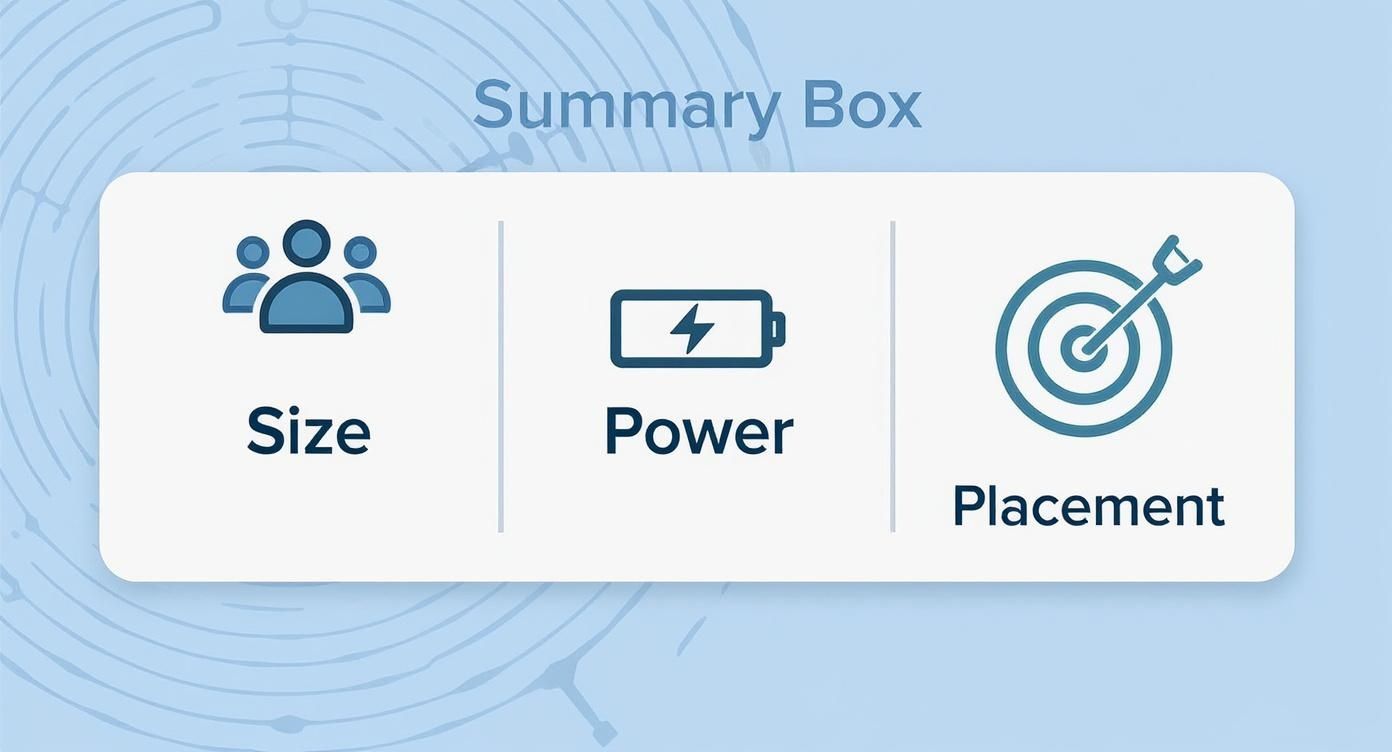
As you can see, it's about matching the fan to your needs, ensuring you have enough power, and placing them strategically to create a bug-free bubble.
Fortify Your Inner Circle
With your outer perimeter set, your fly fans become the star players—the inner guard for your picnic table. They create the final, nearly impenetrable barrier directly over your food. This one-two punch of a deterrent perimeter and a direct-action inner shield lets you relax and enjoy a meal without constant swatting.
This layered strategy shows how camping has evolved. The global camping equipment market is valued at around USD 20.9 billion in 2025 and is projected to climb to USD 28.1 billion by 2030. As more people get outdoors, they're investing in solutions that make camping more comfortable. You can read more about the growth of the camping equipment market to see how big this trend is.
When planning your fly defense, it helps to see how different methods stack up.
Comparing Fly Defense Methods for Campers
| Method | Effectiveness | Best For | Potential Drawbacks |
|---|---|---|---|
| Fly Fans | High | Directly over food on a table. Works best in low-wind conditions. | Requires batteries; less effective in strong breezes. |
| Citronella Products | Moderate | Creating a scented perimeter around a larger area. | Smoke can be irritating to some; effectiveness drops in windy weather. |
| Thermacell Repellers | High | Establishing a "zone of protection" up to 15-20 feet. | Needs repellent mat and fuel cartridge refills; initial cost is higher. |
| Fly Traps (Sticky/Bait) | Moderate | Luring flies away from your main area. | Can be unsightly and fill up quickly; bait can have a strong odor. |
| Screen Tents | Very High | Full-enclosure protection for the whole dining area. | Bulky to pack and requires setup time; can feel restrictive. |
Ultimately, the best defense is a smart combination. No single product is a silver bullet, but layering them covers all your bases.
By thinking in layers, you stop fighting flies reactively and start preventing them proactively. You create a system where each part supports the others, ensuring your dining area remains a fly-free sanctuary.
Smart Food Prep and Cleanup to Deter Flies

The best way to deal with flies while camping is to make sure they never see your campsite as a buffet. It all comes down to prevention. Focus on smart hygiene habits that turn your dining area into a no-fly zone from the start.
This proactive approach matters more than ever. Camping has exploded in popularity, jumping from 48 million U.S. households in 2020 to 92 million in 2022. With more people outdoors, keeping a clean, pest-free site is crucial.
Prepare Food with Purpose
Think of food prep as your first line of defense. Instead of chopping and mixing on the same table where you'll eat, set up a separate prep station a short distance away. This move keeps messes and strong food smells contained and away from your dining spot.
Before you start, get your trash can ready—one with a tight-sealing lid. The smells from vegetable peels, meat scraps, and packaging are a dinner bell for every fly in the area.
Minimizing food attractants is the golden rule of a clean campsite. Every crumb is a signal to flies that the party's at your place.
Smart food management helps tremendously. You can find practical tips for reducing food waste that work just as well in the woods as in a commercial kitchen. Less food waste means fewer pests.
Master Your Cleanup
When the meal is over, clean up immediately. Pack all leftovers into airtight containers and stash them securely. Leaving food out, even for a few minutes, is an open invitation for flies to land and lay eggs. For more on this, read up on how to prevent food contamination.
Washing dishes at a campsite also requires a specific strategy. The three-bin system is your best friend: one for washing, one for rinsing, and a third for sanitizing. The most critical step is disposing of the dirty dishwater. Always use a designated campground station. If that's not an option, strain out any food particles and scatter the water far from your site and any water sources. This prevents you from creating a new fly magnet right next to your tent.
Take Back Your Outdoor Meals
Enjoying a peaceful, fly-free meal while camping isn't about luck—it's about having a smart plan. The secret is combining proactive defenses with good campsite hygiene. It's about creating a space where flies simply don't want to be.
Your first line of defense is on the table. Strategically placed fly fans create an invisible barrier that disrupts their flight and vision. Push that defense outward with a perimeter of citronella torches. This layered protection keeps most pests from ever getting close to your food.
The best way to deal with dining flies camping is to be proactive, not reactive. You stop the problem before it starts by making your campsite completely unappealing to pests from the get-go.
Of course, this is all backed by smart habits. Storing food in airtight containers, wiping up spills instantly, and keeping trash tightly sealed eliminates the smells that draw flies in.
When you put these pieces together, you build a complete system instead of just swatting at individual flies. This approach lets you ditch the frustration and get back to what matters: enjoying great food and making memories outdoors.
Your Top Camping and Fly Questions Answered
Theory is one thing, but practice is another. Here are quick answers to the most common questions campers have about keeping their site fly-free.
How many fly fans do I actually need?
A good rule of thumb is one fan for every two to three people.
For a standard four-person picnic table, two fans at opposite ends work perfectly. This creates an overlapping field of air with no gaps.
For a larger 6-8 person table, use three fans: one on each end and a third in the middle. This ensures total coverage, especially with a big spread of food.
Are fly sprays safe to use around food?
Steer clear of chemical insecticide sprays near your dining table or food prep areas. It’s too easy for chemicals to drift onto your food and cooking surfaces—a risk not worth taking.
Stick with physical deterrents like fly fans. You can supplement with natural repellents like citronella candles, but place them on the edge of your dining area, not on the table. For a truly foolproof, chemical-free zone, nothing beats a screened-in dining tent.
When it comes to dining flies camping, prevention and physical barriers are always better than chemicals. It keeps your food safe and respects the nature you're there to enjoy.
What’s the smartest way to handle trash?
Lock down odors immediately.
Use a trash can with a tight-sealing lid or heavy-duty trash bags you can tie off securely after every use. A single forgotten food scrap can attract a swarm.
Pro tip: Once your bag is sealed, hang it from a tree branch a good distance from your camp, especially your kitchen and tent. And if you're in a developed campground, take your trash to the designated bins daily. A clean site is an uninviting site for pests.
Ready to enjoy peaceful, fly-free meals on your next outdoor adventure? The innovative fly fans from MODERN LYFE create a reliable barrier to protect your food. Shop now and reclaim your campsite dining experience.

